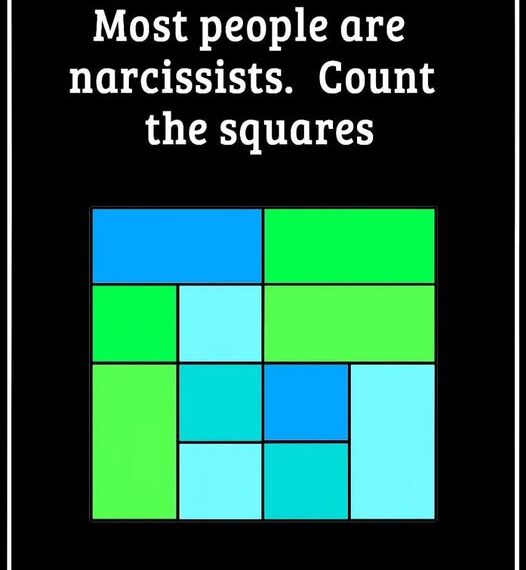A simple puzzle has been circulating online, sparking heated debates, playful arguments, and even a few bruised egos. It’s a basic image—a grid with squares—and a straightforward instruction:
“Count all the squares.”
At first glance, it seems easy. But here’s the twist: most people get the answer wrong. Why? Because they only count what they want to see. And, perhaps more importantly, they assume their first impression is right.
This puzzle doesn’t just test your attention to detail—it reveals something deeper: our tendency to overestimate ourselves.
The Puzzle: A Grid of Squares
Imagine a square divided into smaller squares—a grid, usually 4×4. The challenge is simple:
“How many squares do you see?”
You might instinctively say 16, because there are 4 rows and 4 columns. But if you stop there, you’re only scratching the surface.
The real answer is far more nuanced.
Why This Puzzle Went Viral
Puzzles like these play on a core aspect of human psychology: perception versus reality. When people are told that “most people fail this” or “only geniuses get it right,” their egos get involved.
Suddenly, it’s not just a puzzle—it’s a test of intelligence, of competence, of being better than average.
It’s here where the narcissistic angle comes in.
We want to be right.
We believe we’re observant.
We assume we’re smarter than the next person.
So, when we see 16 squares, we feel confident. We announce our answer. And then someone else says “No, it’s 30,” or “Wait—there are 40,” and our confidence wavers. We go back, recount, feel a bit silly. Maybe we missed a few. Maybe we rushed.
This humble puzzle humbles us.
Why Most People Get It Wrong
The issue isn’t the math—it’s the mindset. Most people fail to consider the hidden patterns, the combinations, and the overlapping elements.
They focus on the obvious and stop thinking once they’ve hit what seems like a “complete” answer.
That’s where the “narcissist” part of the headline comes in. It’s not literal, of course. But it speaks to a common human trait:
Overconfidence in our own perception and reasoning.
Step-by-Step Breakdown: How to Count All the Squares
Let’s walk through the actual process of counting all the squares in a typical 4×4 grid (this example can be adjusted for variations in puzzle design):
1. Count the Smallest Squares (1×1)
This is what most people see first.
- 4 rows × 4 columns = 16 small squares
Easy.
2. Count the 2×2 Squares
Each 2×2 square covers 4 small squares. These can be formed by selecting a starting square and expanding to the right and downward.
- A 4×4 grid can fit 3 rows of 2×2 and 3 columns, giving:
3 × 3 = 9 squares
Now we’re at:
16 (1×1) + 9 (2×2) = 25
3. Count the 3×3 Squares
A 3×3 square spans three small squares in each direction.
- You can fit 2 rows and 2 columns of these:
2 × 2 = 4 squares
Running total:
25 + 4 = 29
4. Count the Largest Square (4×4)
There’s only one full-size square—the entire grid itself.
- Add 1:
29 + 1 = 30
So, the correct answer is:
✅ 30 squares
But wait… some people still claim more.
Bonus Squares: Are There Really More Than 30?
Some versions of this puzzle include:
- Inner-line squares (squares within the lines of larger squares)
- Overlapping or off-centered squares
- Bold borders that form additional visual squares
- “Hidden” squares formed by intersections
Depending on the version, you might be able to count as many as 40 or 50 squares, but in a standard 4×4 grid with uniform squares, 30 is typically the correct and intended answer.
What This Puzzle Really Reveals
So why does this go beyond a simple counting game?
Because the moment we see a simple visual, we assume we understand it. We jump to a conclusion. We might even argue our answer is right without double-checking.
This puzzle is a perfect metaphor for:
- How we trust first impressions
- How we underestimate complexity
- How we overestimate our correctness
- How we often resist being wrong
Sound familiar?
It mirrors the way people interact in daily life—especially online. Whether it’s debating facts, opinions, or politics, people often cling to their initial belief… even when the evidence says otherwise.
The “Narcissist” Clickbait – Why It Works
Let’s talk about the headline:
“Most People Are Narcissists – Count the Squares”
It grabs attention. It makes you feel like this isn’t just a puzzle—it’s a personality test.
And in a way, it is.
It challenges:
- Your ability to be thorough
- Your willingness to re-examine your own beliefs
- Your openness to being wrong
That’s why it sticks with you. That’s why people share it. That’s why it sparks discussion (and sometimes, arguments) in the comments section.
Because it’s not just about logic—it’s about ego.
Share It and Watch What Happens
Next page





